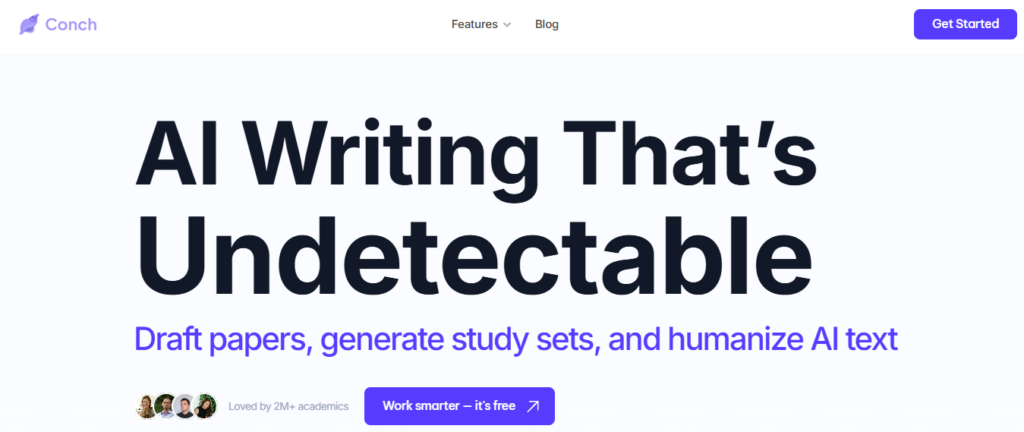Crafting an academic paper can be a daunting task, especially when it comes to understanding and integrating different types of research. Census data can be especially challenging because it can serve as both a primary and secondary source, depending on how it is approached. This guide will help you clearly understand the differences between these two classifications and the importance of recognizing them. If you’re feeling overwhelmed, learning how to use AI to write a paper can also be a game-changer—helping you organize your thoughts, generate outlines, and streamline the writing process while ensuring academic accuracy.
In particular, we will help you understand how census data is primarily a firsthand source, but it can become secondary when referenced in a research project. Conch AI’s AI writing tool can make your research and writing process smoother and more efficient, so you can focus on achieving your academic goals.
What Is Census Data?

Census data is the organized gathering of detailed information about a population, typically carried out by government bodies at set intervals. This process aims to collect comprehensive facts about people living in a country or region. For example, in the United States, the Census Bureau performs a nationwide census every ten years. This decennial event collects essential demographic, economic, and social statistics that reflect the current state of the population.
The Information Collected Includes Several Key Areas
Population counts and geographic distribution
How many people live in a given area, and where are they located?
Household details
Data about the size of families and the relationships between household members.
Economic indicators
Information on income levels, employment status, and occupation types.
Social characteristics
Insights into educational attainment, languages spoken, and other cultural factors.
Census data is crucial for multiple reasons. It helps governments make informed decisions about resource allocation and public services. Researchers rely on it to analyze societal patterns and trends. Additionally, policymakers utilize this data to design programs that address the diverse needs of various communities.
In today’s digital age, tools like Conch AI enhance the way census data is analyzed and interpreted. This tool helps simplify your research on census data and boost the accuracy of your findings. By efficiently summarizing reports, generating clear drafts, and helping you critically evaluate sources, Conch AI makes it easier to produce credible, high-quality work with less effort.
Join Over 2 Million Students and Ace your Classes with our AI Writing Tool
Join millions of students to write papers and ace exams with Conch AI’s AI writing tool. We built this tool because we were tired of spending endless hours on citations, study guides, and rewrites. Unlike general AI tools, Conch AI understands what students need:
- Instant citations that professors accept
- Stealth writing that bypasses detection
- Study tools that help you learn the material
Our Chrome extension brings these superpowers right to your research workflow, while our lecture recording feature takes notes for you so you can focus on understanding concepts. Try our free plan today and see why students tell us they’re saving 10+ hours a week with Conch AI. When you’re ready for unlimited access, our Limitless Plan gives you everything you need to transform your academic experience. Join over 2 million students and ace your classes with our AI writing tool!
Related Reading
- How to Calculate H Index
- How to Write an Informative Essay
- Technology Essay
- How to Write a Header for an Essay
- How to Write a Biography Essay
- How to Write a Reflection Paper
- How to Write an Encyclopedia Entry
- Speech Analysis Example
- What is a Good H Index
Reasons Why Census Data Is Considered a Primary Source

Census data is classified as a primary source because it is original, systematically collected information directly from the population by official agencies, providing unprocessed, factual evidence about demographic and socioeconomic status at a given time. Its authenticity, direct documentation, and foundational role in research underscore its primary source status.
Direct Collection by Government Agencies
Census data is gathered through official, systematic processes conducted by authorized government bodies, such as the U.S. Census Bureau. This data is collected directly from individuals and households via surveys and questionnaires, making it a firsthand account of the population at a specific point in time. Because it is raw and unaltered information obtained straight from the source, it qualifies as a primary source.
Provides Unfiltered Demographic Evidence
The census captures raw demographic details including population size, age and gender distributions, household composition, employment status, income levels, education, and language use. These unprocessed data points serve as direct evidence of societal characteristics without interpretation or modification, which is a hallmark of primary source material.
Foundation for Historical and Social Research
Historical census data offers a snapshot of societal conditions at various points in time, enabling researchers to track changes such as migration trends, economic development, and cultural shifts. This makes census data invaluable for historians and social scientists as a primary source that documents factual information about populations and communities over time.
Authentic and Reliable Data
Because census data are collected through a rigorous, standardized methodology by official agencies, they are considered highly credible and accurate. The process involves direct engagement with the population, ensuring that the data reflects real conditions without secondary interpretation or bias at the point of collection.
Basis for Secondary Analysis
While census data itself is primary, it often serves as the foundational raw data for further analysis, interpretation, and reporting in academic studies, policy research, and demographic trend analysis. Once analyzed or combined with other data, these derivative works become secondary sources, but the original census data remains a primary source.
Related Reading
- Essay on Respect
- Essay About Bullying
- Why I Deserve This Scholarship Essay
- Is a Documentary a Primary Source
- Are Textbooks Primary Sources
- Essay About Death
- How to Write a 4 Paragraph Essay
- Finance Research Paper Writing
Reasons Why Census Data Is Considered a Secondary Source

Census data is a primary source when it is the original, unaltered dataset collected directly from the population. However, once it is processed, interpreted, or incorporated into academic studies, reports, or media articles, it becomes a secondary source. Understanding this distinction is essential for researchers, students, and professionals who rely on census information.
Academic Interpretations Transform Census Data
When scholars or researchers analyze census data, they move beyond the original raw numbers. Their studies interpret, contextualize, and often combine census data with other information to draw broader conclusions. For example, a sociological paper exploring urban migration patterns based on census figures is not using the census as a primary source but as a secondary one. The original data is filtered through academic analysis, making the work a secondary interpretation.
Processed and Aggregated Data as Secondary Sources
Raw census data is extensive and complex. When this data is summarized, organized into charts, tables, or reports, it becomes a secondary source of information. For instance, a government report showing the average national income over several years, derived from census data, is no longer the original dataset but a processed version. Similarly, graphs illustrating population growth trends compiled from multiple census years represent secondary data. These formats make the information more accessible but remove it from its original, unprocessed form.
Secondary Reports and Media Usage
News articles, government briefings, and public reports that reference census data while adding interpretation or commentary also qualify as secondary sources. For example, a news story analyzing poverty trends based on census statistics or a government summary discussing population changes in a region both depend on primary data but include additional analysis. This contextual framing and explanation shift the material from primary to secondary status.
Uses of Census Data in Research

Census data is an essential resource that underpins research across a wide array of disciplines. By providing detailed and reliable information about populations, it enables researchers and decision-makers to gain deep insights and make informed choices.
Demographic Analysis
One of the primary uses of census data is in demographic research. It provides a comprehensive snapshot of population characteristics, including age distribution, ethnic composition, income brackets, and educational attainment. Researchers utilize these details to examine social patterns, identify inequalities, and understand how populations vary across different geographic regions.
Historical Research
Census records are invaluable for historians studying societal changes over time. By analyzing data on migration trends, urban growth, and population shifts, historians can trace the economic transformations and cultural developments that have occurred. This historical perspective helps to contextualize how societies have evolved through various periods.
Informing Public Policy
Governments rely heavily on census data to shape effective public policies. Accurate population information guides the allocation of resources, planning of public services like healthcare and education, and the design of targeted social programs. This ensures that interventions are tailored to meet the specific needs of communities.
Market and Business Research
In the commercial sector, census data is a powerful tool for market research. Businesses analyze demographic information to understand better their customer base, tailor product offerings, and develop effective marketing campaigns. Additionally, census insights help identify emerging markets and opportunities for expansion.
Benefits and Limitations of Census Data

Benefits of Census Data
Comprehensive Population Coverage
One of the most significant advantages of census data is its broad and detailed coverage. It captures a wide range of demographic information across entire populations, making it an essential resource for policymakers, researchers, and planners. This extensive scope allows for in-depth analysis of population size, distribution, and characteristics at various geographic levels.
Historical Consistency for Longitudinal Studies
Census data is collected at regular intervals, often every ten years, using standardized methods. This consistency over time provides a reliable basis for tracking demographic changes and trends. Researchers can utilize this historical continuity to examine social, economic, and demographic shifts across decades, facilitating informed decision-making and policy development.
Limitations of Census Data
Potential Data Collection Bias
Despite its thoroughness, census data is not immune to inaccuracies. Certain groups, such as marginalized communities or transient populations, may be undercounted due to accessibility issues or a lack of trust. Conversely, some populations might be overrepresented. These biases can skew results and affect the accuracy of conclusions drawn from the data.
Limited Qualitative Insights
While census data excels in quantitative demographic information, it often lacks depth in qualitative aspects, such as social attitudes, behaviors, and motivations. This limitation means that census data alone may not provide a complete picture of societal dynamics. Researchers frequently need to supplement census data with surveys, interviews, or ethnographic studies to capture these nuanced insights.
Related Reading
- Ai Annotated Bibliography
- Leadership Essay Examples
- Social Media Argumentative Essay Topics
- Topic Sentence vs Thesis Statement
- Evaluation Essay Examples
- National Honor Society Essay Examples
- Proposal Essay Examples
- Diversity Essay Examples
- Literary Analysis Essay Examples
- Informative Essay Topics
- Dyslexia Writing Examples
Join Over 2 Million Students and Ace your Classes with our AI Writing Tool

Join millions of students to write papers and ace exams with Conch AI’s AI writing tool. We built this tool because we were tired of spending endless hours on citations, study guides, and rewrites. Unlike general AI tools, Conch AI understands what students need:
- Instant citations that professors accept
- Stealth writing that bypasses detection
- Study tools that help you learn the material
Our Chrome extension brings these superpowers right to your research workflow, while our lecture recording feature takes notes for you so you can focus on understanding concepts. Try our free plan today and see why students tell us they’re saving 10+ hours a week with Conch AI. When you’re ready for unlimited access, our Limitless Plan gives you everything you need to transform your academic experience. Join over 2 million students and ace your classes with our AI writing tool!

Leave a Reply